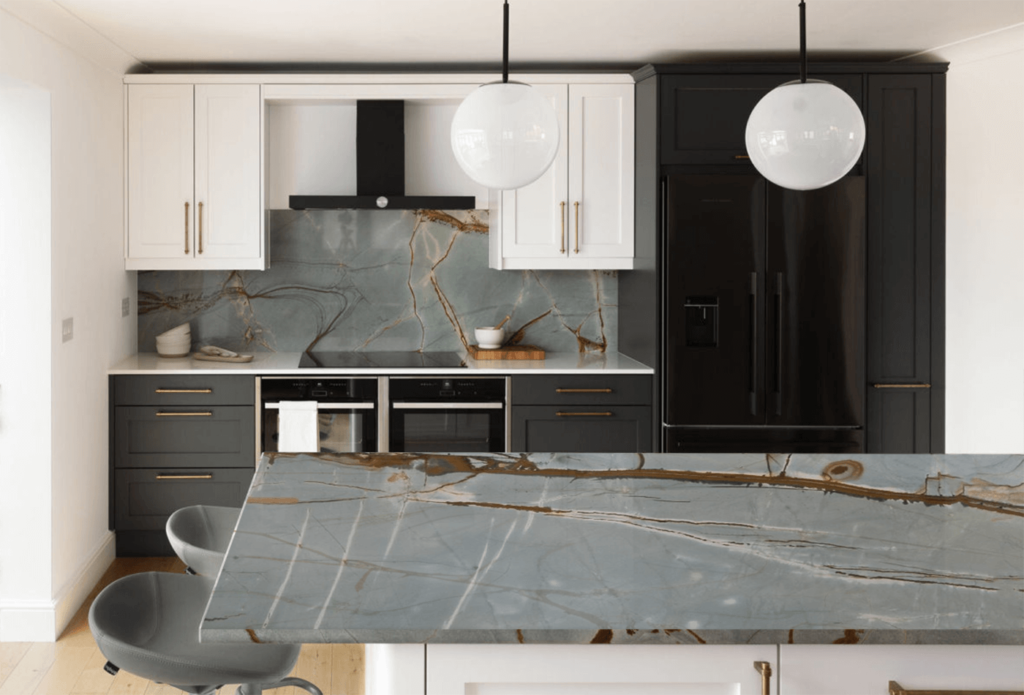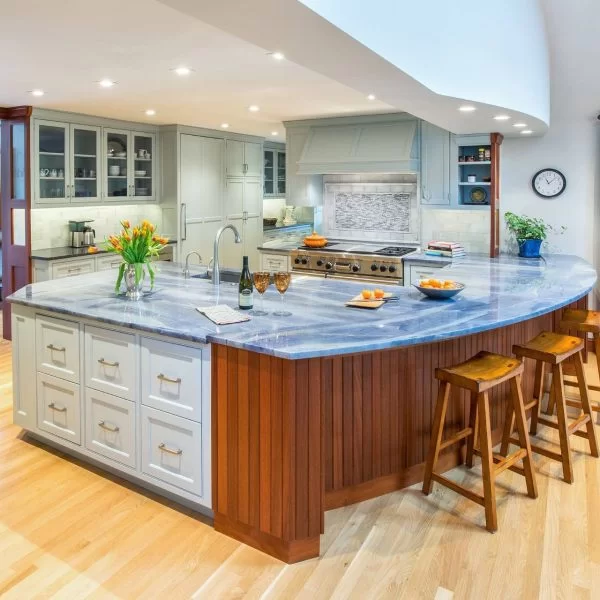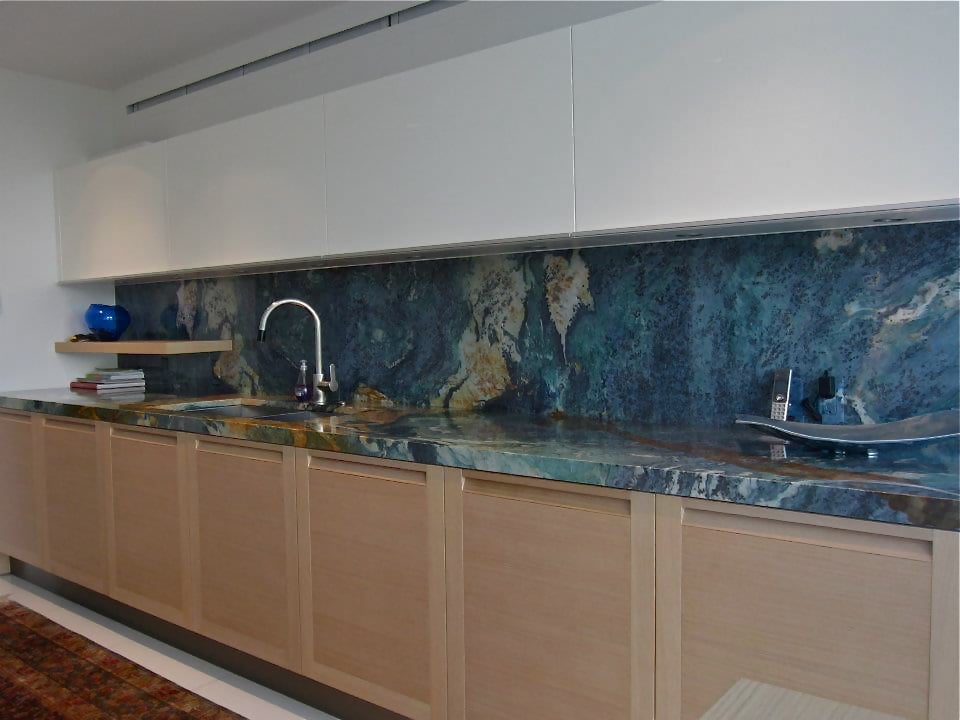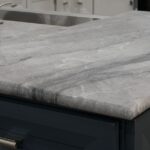Although exquisitely rare, blue quartzite countertops are a sight for sore eyes – attracting many enthusiasts for unique interior design throughout the U.S. Quartzite is a porous natural stone found and quarried all over the world, featuring a large array of colors that enrich the market. In this article, find out what blue quartzite countertops bring to the table, especially when compared to the classic white version of the material.
Don’t miss: All About Seams in Quartzite Countertops
What are blue quartzite countertops?
It isn’t hard to understand blue quartzite slabs. Although most people tend to imagine two or three different hues when it comes to natural stones – extravagant colors are unusual in nature, after all – the lack of visual variety couldn’t be further from the truth. Why is that the case, though?
Well, quartzite is a metamorphic rock that is formed when sandstone undergoes a process of heat and pressure deep within the Earth’s crust, causing it to recrystallize and become much harder and more durable than its parent rock, sandstone. The transformation from sandstone to quartzite occurs when the individual quartz grains in the sandstone recrystallize and fuse, creating a durable rock with a granular texture.
That said, the diverse colors in quartzite, including blue, are the result of various mineral impurities, as well as structural and environmental factors during the transformation process such as heat, pressure, and light. For example, the presence of iron oxide can give quartzite shades of red, orange, or brown, while the presence of feldspar impurities can lead to pink or reddish hues. In the case of blue, the presence of minerals like hematite can create cold colors, even green.
Benefits of blue quartzite countertops
Similarly to countertops made from other natural stones – like granite and marble, as well as engineered stones like quartz – blue quartzite offers lifetime advantages that cemented its way into the national catalog.
Here are some of the selling points of a blue quartzite slab:
- It has a distinctive and beautiful appearance with varying shades of blue, gray, and other colors. Each slab is unique, which means your countertop will have a one-of-a-kind look that can become a focal point in your kitchen or bathroom;
- Quartzite is a very hard and durable natural stone, which makes it resistant to scratches, chips, and cracks under due care. It can withstand the daily wear and tear of a busy kitchen, making it a long-lasting countertop option;
- It is also heat-resistant, meaning it can handle hot pots, pans, and cooking utensils without being damaged. However, it’s still advisable to use trivets or heat-resistant pads to protect the surface and maintain its bright appearance;
- Blue quartzite is relatively low-maintenance, with regular cleaning with mild soap and water being usually sufficient to keep it looking great. Sealing the countertop periodically can help maintain its appearance and protect it from stains;
- Quality countertops made from blue quartzite can enhance the resale value of your home since it’s seen as a premium feature that many homebuyers find attractive;
- If you want to go beyond counters, know that it can be used in various applications, including backsplashes and decorative wall cladding. Its versatility makes it suitable for both kitchen and bathroom designs.
It’s important to note that while blue quartzite offers these benefits, it also requires proper care and maintenance to ensure its longevity and appearance. Additionally, due to its rarity, it can be relatively expensive compared to some other countertop materials – but many homeowners find the unique beauty and durability well worth the investment regardless.
The difference between quartz and quartzite
This is a common question faced by many in their search for the ideal natural stone. After all, sometimes they all look the same – so when their names are also similar, their individualities might get mixed up, affecting your choice.
Well, the main difference here is simple: quartzite is natural, whereas quartz is a manmade product that comes from quartzite. Quartz countertops are engineered stone surfaces made primarily of quartz crystals (typically around 90-95%) bound together with resins and pigments. In other words, they are manufactured in a controlled environment, while quartzite is collected from natural quarries.
The primary thing to consider, then, lies in their composition, formation, and versatility. Quartz is non-porous – meaning it doesn’t have to be sealed like quartzite – and can be found in a vast array of colors on the market. That said, each has its own set of advantages and considerations, so the choice between them often depends on personal preferences, budget, and specific application requirements.
Don’t miss: Tips on How to Restore Marble Countertops
Highlights of blue quartzite countertops
Now it’s time to know what to look out for when browsing through endless catalogs on the Internet. Below, we’ve listed four main candidates to consider for your home design.
Nevertheless, it’s always a good idea to consult with a professional stone supplier or installer to assess your specific needs, budget, and aesthetic preferences. They can guide you in selecting the right stone and offer maintenance tips to keep your countertops looking their best for many years to come.
Check out the following options:
Blue Roma Quartzite

For its striking blue and gray hues with veining that can vary from subtle to bold, it often features a mix of blue, gray, and white tones, creating a visually appealing and elegant countertop.
Azul Imperiale Quartzite

It is prized for its deep blue and gray colors, with striking white and gold veins. The contrast of colors and patterns in this stone makes it a luxurious and eye-catching choice for countertops.
Fantasy Blue Quartzite

This one showcases a combination of deep blue, gray, and black colors with distinct veining. It can create a dramatic and modern look, making it an attractive option for contemporary kitchen designs.
Blue Louise Quartzite

Characterized by its rich blue and gray colors, often with striking white or golden veining, this stone offers a bold and elegant appearance that can make a strong statement in any kitchen or bathroom.
Find high-end quartzite slabs at Eagle Stones
Based in Sarasota, Florida, we offer the best experts in town for any natural-stone-related business, including supply, installation, and maintenance. If you want to check out our full catalog of quartzite stones, don’t hesitate to contact us today.
We’ll go to your house and even give you a free estimate! What are you waiting for?



